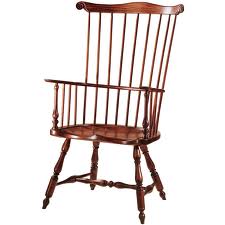
The Windsor chair hailed from the United Kingdom hundreds of years ago and is still in popular production today. However, the term Windsor can be confusing because the primary production center for these chairs was High Wycombe, England.
A Windsor chair is constructed with a solid wooden seat with the legs and back fixed into it. The back and the arm pieces (if arm pieces are includued) are made with steam-bent wood.
There are many different forms of a Windsor, a few of which include the comb-back, the sack-back, the fan back, the continuous arm and the hoop-back. (The comb-back Windsor chair is pictured here).
As with a number of things throughout history, the Americans and the British differed on how to make a Windsor.
During the 18th century, American Windsors were commonly constructed of three species of wood. A soft wood such as poplar, pine or bass was typically used for the seat. Ring porous species of wood like ash, oak and hickory steamed and bent well. Their flexibility made them ideal for the slender spindles.
Non-ring porous woods like maple are stiff, which made for sharp turnings. The is made these woods great for legs and the undercarriage.
English Windsors, on the other hand, had seats made of elm. This hard wood was typically not as thick as the American’s because elm was stronger than pine. Also differing, were the depth of the scoop into the seat. The English dip wasn’t as pronounced because elm is much more difficult to sculpt than the softer woods made by American chair makers.
Differences aside, the Windsor chair is an renowned classic that belongs inside any home outfitted with traditional decor.
